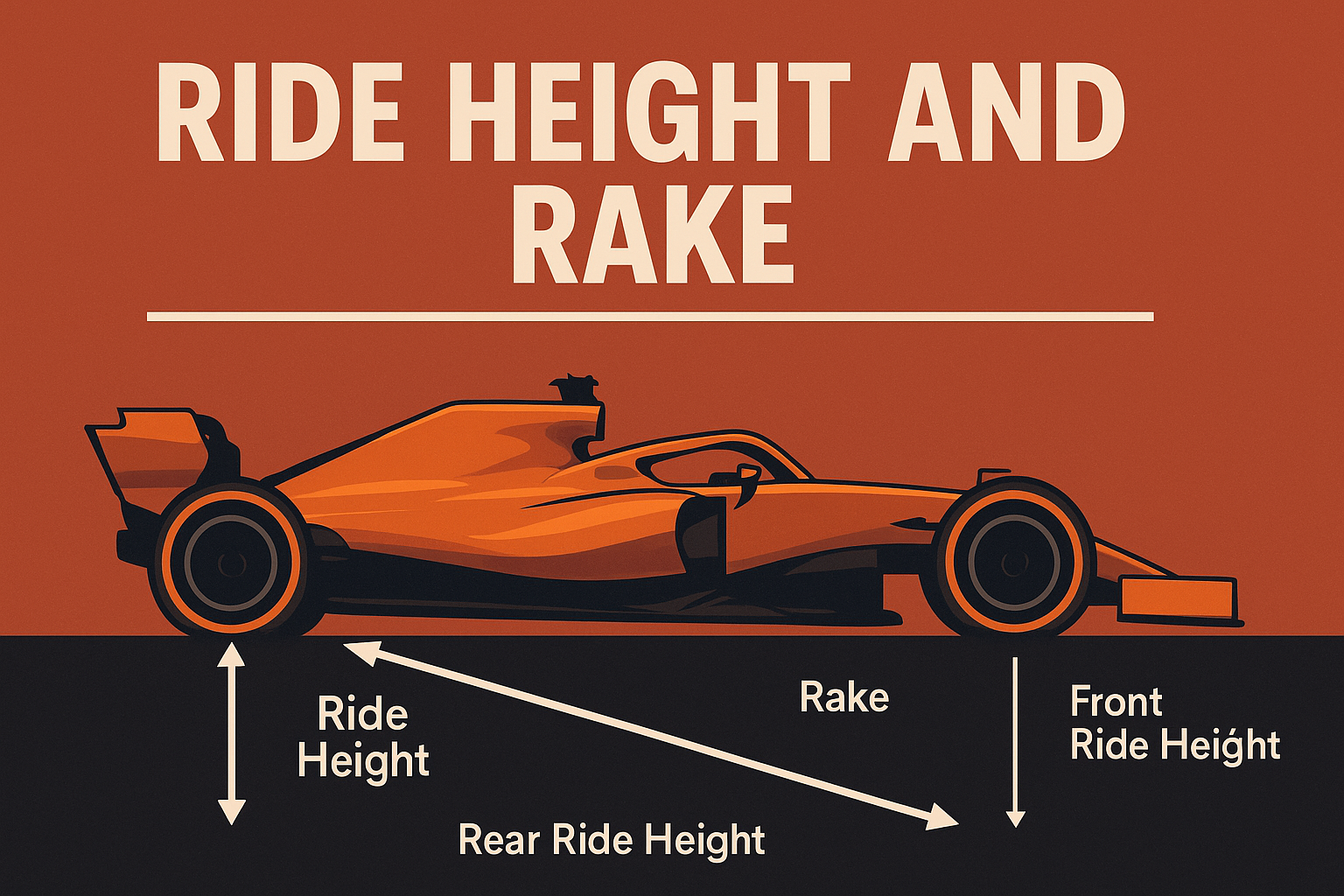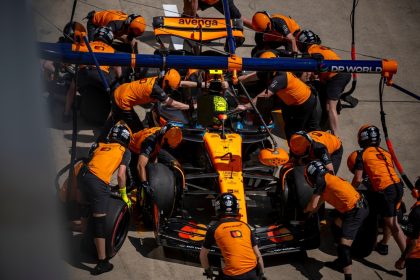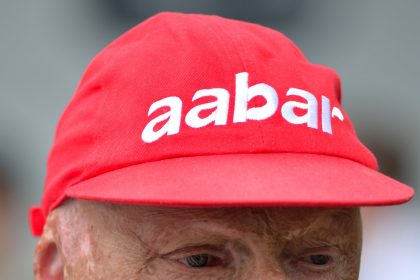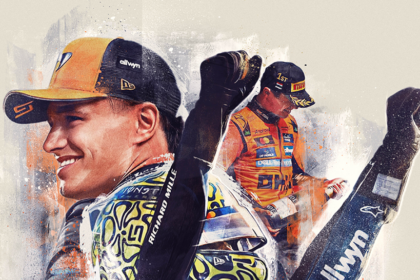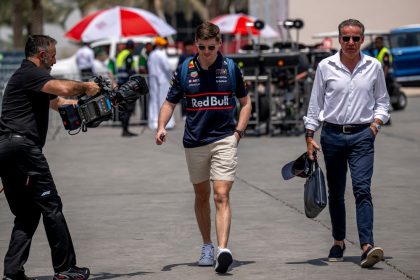Alright, F1 fam, buckle up! Today we’re diving under the skin of every Formula 1 car to talk about the most misunderstood, over-argued, and absolutely game-changing part of car setup: ride height and rake. If you think this is just about how high the car sits off the ground, you’re missing the entire plot. This is the story of how millimeters make champions, how a few degrees of tilt can turn a midfield car into a podium monster, and how the world’s best engineers have spent decades fighting, innovating, and sometimes even cheating (yeah, I said it) to unlock the secrets of car setup.
- The Ground Rules: What the Heck Are Ride Height and Rake?
- The Evolution: From Skirts to Skirmishes
- The Science: Why Millimeters Matter
- The Human Drama: When Setup Makes or Breaks a Weekend
- The Setup Secrets: How Teams Actually Do It
- The Controversies: When the FIA Says “Nope!”
- The Modern Era: Who’s Winning the Rake Wars in 2025?
- The TikTok Take: Why Fans Should Care
- #fyp
So grab your pizza, tell your girlfriend you’ll explain later, and let’s get emotional about the dark art of ride height and rake. Because trust me, this is where the magic happens. 🏎️🔥
The Ground Rules: What the Heck Are Ride Height and Rake?
Let’s start with the basics, because even my dog Vettel gets confused sometimes. Ride height is the distance between the bottom of the car and the ground. Simple, right? But here’s where it gets spicy: rake is the difference in ride height between the front and rear of the car. Imagine your car is doing a permanent wheelie (rear higher than front)—that’s positive rake. If the front is higher (which almost never happens in F1), that’s negative rake.
Why does this matter? Because in F1, the air under the car is just as important as the air over it. Lowering the car reduces the amount of air sneaking underneath, which means less drag and more downforce. But if you go too low, you risk scraping the floor, stalling the diffuser, and basically turning your car into a very expensive snowplow.
As the legends at iGPFun put it:
Ride height and rake have a profound effect on aerodynamic efficiency, speed and grip. More rake leads to more oversteer; less rake is conductive to understeer.
— iGPFun Ride Height & Rake Guide
The Evolution: From Skirts to Skirmishes
Let’s take a quick trip down memory lane. Back in the late 1970s, Lotus dropped the bomb with ground effect cars—basically, they turned the floor into a giant vacuum cleaner, sucking the car to the track. Teams slammed their cars as low as possible, added sliding skirts, and watched the lap times tumble. But it was dangerous. Cars bounced (“porpoised”), drivers got battered, and the FIA eventually said, “Enough!”—banning ground effect and mandating minimum ride heights in the early ‘80s.
But F1 engineers are like racetrack goblins—they never stop scheming. Through the ‘90s and 2000s, teams kept tweaking ride height and rake, searching for that perfect balance between downforce and drag. Then came the Red Bull era, and Adrian Newey (the Gandalf of aerodynamics) brought the high-rake philosophy to the mainstream. Suddenly, everyone was talking about “rake wars” between Red Bull and Mercedes.
And let’s not forget the 2012 “reactive ride height” controversy, when Lotus (and others) tried to sneak in a system that adjusted the car’s height under braking. The FIA banned it before it even hit the track, proving once again that in F1, if you’re not pushing the rules, you’re not trying hard enough.
The Science: Why Millimeters Matter
Here’s where it gets nerdy—and awesome. Lowering the car increases the effectiveness of the diffuser, that magical bit at the back that turns airflow into downforce. More rake means the rear is higher, which increases the volume of the diffuser and sucks the car down even harder in corners. But too much rake, and you lose stability on the straights. Too little, and you’re leaving free lap time on the table.
As the folks at Nerdgasm (best blog name ever) explain:
Lowering the car lets less air pass underneath it, which is generally good for reducing drag. Lowering a car with an underbody diffuser generally increases the diffuser’s effectiveness, which produces a significant amount of downforce for very little penalty in drag.
— Motorsports setup: getting ride height right – Nerdgasm
But there’s a catch. If you go too low, you risk “bottoming out”—the car scrapes the track, stalls the diffuser, and suddenly you’re spinning into the gravel. It’s a constant dance between risk and reward, and the best teams are the ones who can walk that tightrope lap after lap.
The Human Drama: When Setup Makes or Breaks a Weekend
Let’s get real for a second. Every F1 fan has watched a race where a team just “gets it wrong” on setup. Maybe the car is bouncing like a pogo stick (hello, porpoising in 2022), or maybe it’s understeering like a shopping cart with a busted wheel. Nine times out of ten, it comes down to ride height and rake.
Remember the 2021 floor rule changes? The FIA tweaked the regulations to cut downforce and target high-rake cars. Red Bull had to scramble, Mercedes smirked, and the entire paddock was thrown into chaos. Suddenly, the setup window was razor-thin, and every millimeter counted.
And don’t even get me started on the 2022 ground effect return. Teams had to relearn everything, balancing ride height to avoid porpoising while still chasing that sweet, sweet downforce. It was like watching a bunch of mad scientists in a wind tunnel, and I loved every second.
The Setup Secrets: How Teams Actually Do It
Alright, let’s get practical. How do teams actually set ride height and rake? It’s not just about cranking a few bolts in the garage. Every change in suspension, tire pressure, camber, or even fuel load affects the ride height. Teams use pushrod length adjustments, telemetry, and a whole lot of trial and error to dial it in.
Here’s a killer YouTube guide that breaks it down for sim racers (but trust me, the principles are the same in real life):
🎥 Sim Racing Setup Guide 07 – Ride Height & Rake
And if you want to see how the pros do it, check out this classic from SAFE is Fast:
🎥 Basic Chassis Set Up 3 – Ride Height, Rake and Weight Jackers
The key takeaway? There’s no “one size fits all.” Every track, every car, every driver wants something different. The best engineers are the ones who can read the data, listen to the driver, and make the right call under pressure.
The Controversies: When the FIA Says “Nope!”
F1 wouldn’t be F1 without a little drama, right? Ride height and rake have been at the center of some of the sport’s biggest controversies. From the ground effect ban in the ‘80s to the reactive ride height saga in 2012, the FIA has had to step in more than once to keep things fair (or at least, less unfair).
Here’s a quick table of the biggest moments:
| Year | Innovation/Controversy | Impact |
|---|---|---|
| 1978-1982 | Ground effect, low ride height | Massive downforce, safety concerns |
| 1983 | Ground effect ban, min. ride height | Reduced downforce, safer cars |
| 2010s | High vs. low rake philosophies | Different aero concepts, performance gap |
| 2012 | Reactive ride height systems | Banned by FIA, technical controversy |
| 2021-22 | Floor/rake regulation changes | Targeted high-rake cars, new challenges |
And let’s not forget the classic quote from the FIA after banning reactive ride height systems:
Any aerodynamic effect created by the suspension should be incidental to its primary function… any device that influences the car’s aerodynamics must remain immobile in relation to the sprung part of the car.
— FIA Technical Regulations, 2012
Translation: Nice try, engineers, but not today.
The Modern Era: Who’s Winning the Rake Wars in 2025?
Fast forward to today—July 14, 2025. The rake wars are still raging, but the game has changed. With the return of ground effect and stricter floor rules, teams are walking a razor’s edge between performance and porpoising. Red Bull, still the kings of high-rake philosophy, have had to adapt, while Mercedes and Ferrari are pushing the limits of low-rake setups.
The difference? It’s all about how you manage airflow under the car. The best teams are using every trick in the book—flexible floors, clever suspension geometry, and hours of wind tunnel testing—to find that perfect balance. And with the championship tighter than ever, every millimeter counts.
As one famous F1 commentator put it:
Ride height and rake are the invisible weapons in every team’s arsenal. Get it right, and you’re a hero. Get it wrong, and you’re nowhere.
— Martin Brundle
The TikTok Take: Why Fans Should Care
Look, I get it. Ride height and rake aren’t as sexy as DRS overtakes or pit stop blunders. But if you want to understand why your favorite team is suddenly three-tenths faster (or slower), this is where you need to look. It’s the secret sauce, the hidden ingredient, the thing that separates the good from the great.
So next time you’re watching qualifying and the commentators start talking about “setup struggles,” you’ll know exactly what’s going on. And when your friends ask why Red Bull is flying through the corners while Mercedes is bouncing down the straights, you can drop some serious knowledge bombs.
#fyp
Want to go even deeper? Check out these links for more on ride height, rake, and the wild world of F1 car setup:
- Sim Racing Setup Guide 07 – Ride Height & Rake (YouTube)
- Basic Chassis Set Up 3 – Ride Height, Rake and Weight Jackers (YouTube)
- Ride Height & Rake – iGPFun
- Motorsports setup: getting ride height right – Nerdgasm
And if you want to see some wild Facebook debates about Porsche GT car rake angles (because why not?), check out this post:
Stay tuned, stay nerdy, and remember: in F1, it’s the stuff you can’t see that wins races. See you at the next Grand Prix, where I’ll be screaming at the TV and explaining to Sofia (again) why “just a few millimeters” can change everything. 🏁







